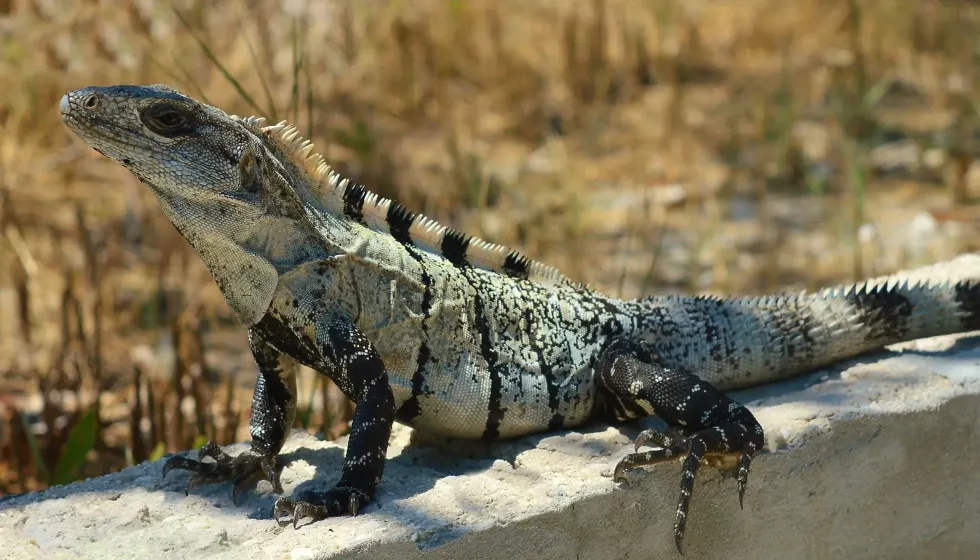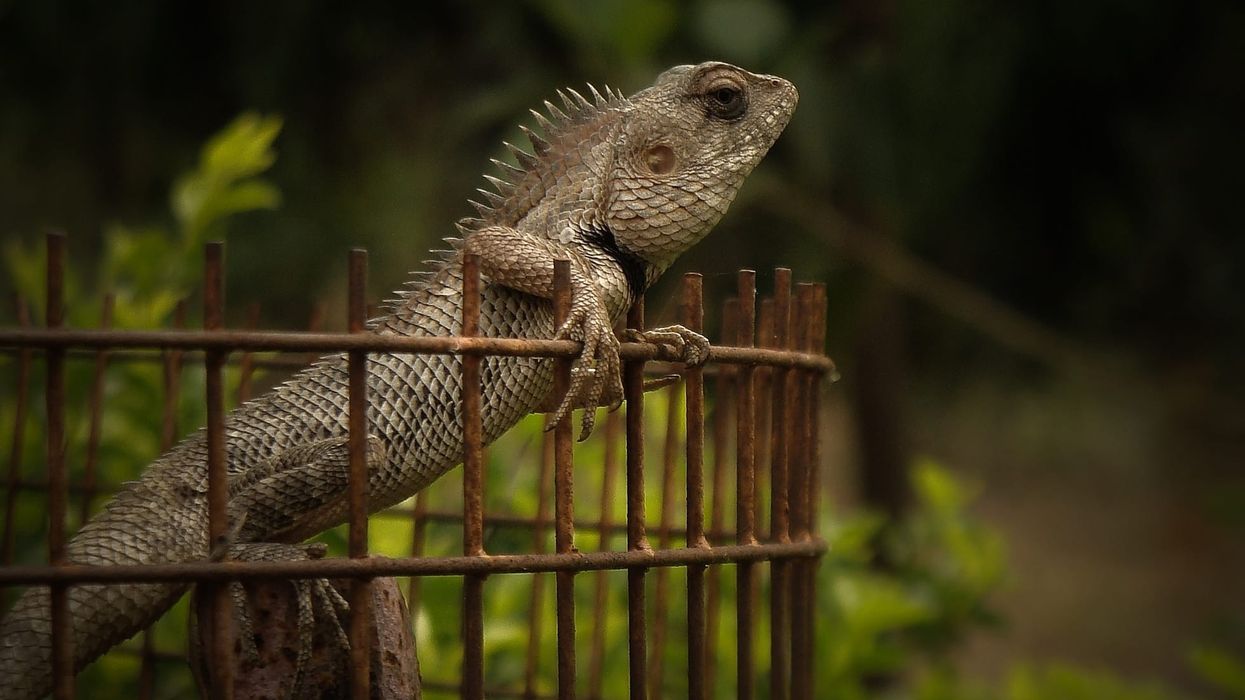Want your child to gain knowledge about terrestrial animals and birds? You may introduce them to these beautiful reptiles. Hopefully, the color palette and the graceful stature of these reptiles will fascinate them and catch their attention.
The common names for a spiny-tailed iguana are the black spiny-tailed iguana, the black iguana, or the black Ctenosaur. In some parts of Central America, it is also known as the 'chicken of the trees'.
This is because the black spiny-tailed iguana is sometimes hunted for its meat in Central America. In Central America, along with spiny-tailed iguanas, green iguanas are also hunted. The tailed iguana (Ctenosaura similis) is also popular in the pet trade.
The spiny-tailed iguana Ctenosaura is a diurnal creature, meaning it is most active in the day. The natural place of dwelling for a black spiny-tailed iguana in the wild is a burrow.
Like reading about this reptile species? Want to know more about the spiny-tail iguana? Continue reading this article to dig deeper into this creature.
If you like reading about the black spiny-tailed iguana, you may also like reading about other reptiles like the lava lizard and sand lizard.
Spiny-Tailed Iguana Interesting Facts
What type of animal is a spiny-tailed iguana?
The black spiny-tailed iguana is a lizard belonging to phylum Chordata, order Squamata, suborder Iguania, and species C. similis.
What class of animal does a spiny-tailed iguana belong to?
The black spiny-tailed iguana belongs to the class Reptilia and the animal is a reptile.
How many spiny-tailed iguana are there in the world?
The spiny-tailed iguana Ctenosaura is found in considerable numbers in the world.
Where does a spiny-tailed iguana live?
The Ctenosaura similis black habitat is amongst the terrestrial vegetation. The tailed iguana (Ctenosaura similis) is found in savannah, grasslands, rainforests, and scrub forests in the wild.
The tailed iguana (Ctenosaura similis) prefers to dwell on lowlands amongst green plants but this species is also found in higher elevations. This species of reptile makes the best use of the green plants to camouflage themselves.
What is a spiny-tailed iguana's habitat?
The black spinytail iguana is found throughout Central America, Mexico, and Colombia. The species is endemic (native species) to Central America, Mexico, and Colombia. Black spiny-tailed iguanas have also been introduced to the United States in the state of Florida.
Who do spiny-tailed iguanas live with?
In the wild, black spiny-tailed iguanas (C. similis) live in colonies. There is a pecking order in a colony of spiny-tailed iguanas which is quite distinct. The colony is usually ruled by a single dominant male. The other males protect their territories against each other but not from the dominant male. These animals are highly territorial.
How long does a spiny-tailed iguana live?
The average lifespan of a male black spiny-tail iguana is more than 20 years of age.
How do they reproduce?
Mating and reproduction take place in specific periods in a year. The males of this Ctenosaur species possess a pair of intromittent organs that are called the hemipenes.
The males inject the hemipenes into the body of the female during mating. The spiny-tailed iguana Ctenosaura is oviparous, meaning they lay eggs.
In the breeding season, the female lays up to 25 eggs. The eggs are laid in a burrow dug by the female. Females migrate to lay the eggs away from the males and are protective of their eggs and nests and defend themselves from other nesting lizards.
The eggs hatch after three to four months. The hatchlings dig their way out of the eggs and the burrows a week after hatching.
It is interesting to note that the young ones come out of the holes together. This gives the lizards a better chance of survival against predators.
Life is tough for these juveniles. It is very interesting to note that the females can lay eggs even if the males are not around.
This is because the sperm remains viable in the female body for a long period of time which enables the female to produce hundreds of young ones in her lifetime. It only takes a few of these reptiles to boost populations in an area.
What is their conservation status?
According to the International Union for Conservation of Nature(IUCN) Red List of Threatened Species, the spiny-tail iguana is has a status of Least Concern. In the world, the population of spiny-tail iguanas is stable. However, the black spiny-tailed iguana is heavily hunted.
Spiny-Tailed Iguana Fun Facts
What do spiny-tailed iguanas look like?
A black iguana is grayish black in color with sharp spines on the back. It has small limbs and a long tail. The dark dorsal region is covered in bands. The dewlap (part of the skin under the throat) is not inflated.
The animal has dark and sombre eyes. Sexual dimorphism is visible. The adults may get tanned. The juveniles are olive green in color and this olive green coat of the young ones of the C similis turns grayish with age.
How cute are they?
Black spiny tailed iguanas are rather imposing with all their spines. The juveniles however are about the size of a human palm and extremely cute to look at.
How do they communicate?
The populations of this iguana communicate with one another using various physical postures. The various neck and body postures that are used by black spiny-tailed iguanas are very interesting to observe. The C similis use their eyes to communicate as well. These reptiles are known to admonish their owners with their eyes and expressions.
How big is a spiny-tailed iguana ?
In length, the male Ctenosaura similis black is 4 ft (1.2 m) and females are 2–3 ft (0.6–1 m) in length. Black spiny-tailed iguanas are the largest species of lizards in the genus Ctenosaura.
How fast can a spiny-tailed iguana move?
This family genus is one of the fastest running species of lizards in the world. The maximum running speed of a black spiny-tailed iguana is estimated to be 21 mph (33.7 kph).
How much does a spiny-tailed iguana weigh?
The spiny-tailed iguana Ctenosaura weighs around 2.2 lb (1 kg).
What are the male and female names of the species?
Male and female black spiny-tailed iguanas have no separate names.
What would you call a baby spiny-tailed iguana ?
Baby black spiny-tailed iguanas are called hatchlings.
What do they eat?
A black spiny-tailed iguana is an omnivore. Black spiny-tailed iguanas are herbivores as well as opportunistic hunters of small animals like grasshoppers, worms, eggs, arthropods, flies, and insects. The juveniles of spiny-tailed iguanas are mainly insectivores. The transition towards choosing plants as food comes with age.
Are they poisonous?
The spiny-tailed iguana is known to bite viciously if it becomes nervous or feels threatened. Their bites may get nasty if they are left untreated.
Would they make a good pet?
These reptiles are kept as pets. It is interesting to note that iguanas when brought home as pets tend to keep their eyes closed at first.
This is their way of coping with the stress of the situation and the new environment. The black spiny-tailed iguana is very aggressive. The pet owner needs to take into account this fact when adopting an iguana.
It is suggested that experienced pet owners are better suited to look after a black spiny-tailed iguana as they tend to bite. The spiny-tailed iguana is not similar in behavior to a green iguana.
Did you know...
The bulkiest of iguanas is the blue iguana or the Cyclura lewisi. The blue iguana is also called the Grand Cayman ground iguana. It is endemic to the island of Grand Cayman. The blue iguana is also referred to as the Cayman Island rock iguana. Clearly, the names reflect the island to which the animal belongs.
The Ctenosaura similis are sedentary animals, meaning spiny-tailed iguanas are non-migratory by nature.
The black spiny-tailed iguana loves to soak and bask in sunlight as it helps it to reach the optimum body temperature.
The Ctenosaura similis prefers to dwell on the ground. However, spiny-tailed iguanas can climb on plants as well. The juveniles may prefer higher elevations to avoid the dangers of predation.
The black spiny-tailed iguana is considered to be an invasive species in South Florida. It is very interesting to note that black spiny-tailed iguanas along with green iguanas and the Varanus niloticus, the beautiful Nile Monitor, are the three non-indigenous species of lizards introduced in Florida.
Now they are found throughout South Florida. The sandy areas here are preferred by the animal.
According to Kenneth Krysko, the diet of spiny-tailed iguanas is important to analyze the impact that it will have on the surrounding ecology. Research shows that the iguana's diet includes other endangered plants and animals. Researchers like Kevin Enge are associated with these works. The diet helps to locate the natural habitat of the animals.
It is usually believed that the black spiny-tailed iguana is not as important as the green iguana when it comes to the pet trade. However, they are slowly becoming popular. The animals are mostly procured from their natural populations.
The Mexican spiny-tailed iguana or the Ctenosaura pectinata is a native of western Mexico. The Ctenosaura pectinata is also referred to as the Mexican spinytail iguana or the Guerreran spiny-tailed iguana.
The food of this animal includes the Brazilian pepper which is considered to be an invasive species. The animals are now being associated with the dispersal of the seeds of the Schinus terebinthifolius. They are also known to prey on their own eggs and juveniles.
If irritated the animal can lash out using its tail. It opens its mouth to express how it feels.
What is the fastest lizard on earth?
The fastest lizard on earth is the perentie monitor lizard whose scientific name is Varanus giganteous. The animal has a speed of 25 mph (40.23 kph).
What is the smallest species of iguana?
The smallest species of iguana is the spiny-tailed iguana. It is found in Costa Rica, Florida, and other places.
Here at Kidadl, we have carefully created lots of interesting family-friendly animal facts for everyone to discover! For more relatable content, check out these monitor lizard facts and frilled lizard fun facts for kids.
You can even occupy yourself at home by coloring in one of our free printable spiny-tailed iguana coloring pages.










